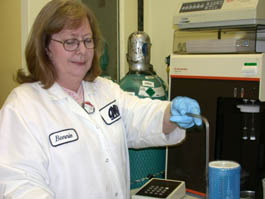
Bonnie Alberico
OMYA, Inc.
After my two kids were well on their way in school I decided to go back to college to improve my financial situation. My first course in Environmental Science stimulated my interest in the world around me. I soon enrolled at Castleton State College and in an Introduction to Geology class during the first semester. Then I knew a bachelors degree in Geology was the background that I wanted for my career plan. Geology offered many outdoor experiences and opportunities, such as studying environmental problems in Mexico and Geology at field camp in Montana. Skills from my geology education supported me in my career at the fine company of OMYA in Proctor, Vermont.
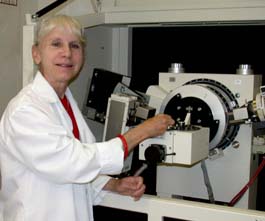
Alice Blount
Mineralogist, OMYA, Inc.
I became steadfastly interested in minerals when I was on a trip as a seven-year old and spent my allowance for a whole month on a set of 12 small minerals. I have never grown up. Now I spend everyday working with minerals and, even better, I get paid to do it! I have found that geoscience is a wonderful career because the work is interesting and, in addition, leisure-time outdoor activities are more enjoyable though having knowledge of geology.
[Picture: Alice Blount with X-ray diffractometer]
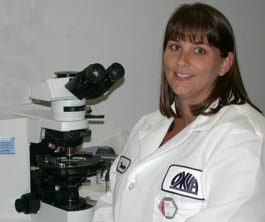
Shannon Foster
OMYA, Inc.
I was hooked on geology at a young age. I remember collecting rocks on the playground and imagining the far away places they came from. In college I loved spending time outdoors learning to read the stories the rocks had to share. Today my geology adventure continues under the microscope in my lab at OMYA and in the geology lab at Castleton State College, where I strive to make my passion for geology contagious to my students.
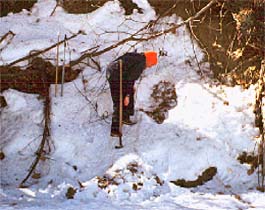
Larry Gatto
Cold Regions Research and Engineering Laboratory
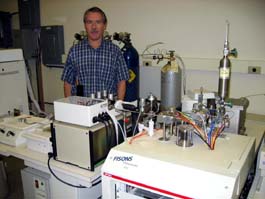
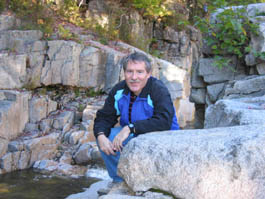
Stephen Howe
Research Geochemist, University at Albany
When I was six years old, I received two shoebox-sized blocks of shale from a Pennsylvania coal mine from my uncle for Christmas, with instructions to carefully split the layers apart to reveal a host of wonders contained within. Over the next couple of days I must have exposed hundreds of delicate fossils of plants typical of the Carboniferous from those two blocks. Soon after I remember acquiring my first chemistry set which I used to grow all kinds of brightly colored crystals with fascinating shapes. So, it would seem that it was inevitable that I would become a geochemist. Although most of my time is spent using the stable isotope mass spectrometer pictured here in my lab at the University at Albany, I also enjoy an occasional excursion to the field to climb on rocks such as this wonderful exposure of Mesozoic granitoids along the Swift River in the White Mountain National Forest of New Hampshire.
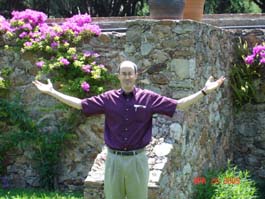
Eric Lapp
Quality Systems Manager, OMYA, Inc.
How I got into geology probably has to do with a childhood interest in the
outdoors, a love of maps of all kinds, exploring and collecting stuff (including
rocks and minerals), and growing up in the beautiful and geologically interesting
town of Chester, VT. Inspiring teachers all along the way really helped,
too. My career
path has wandered from consulting to government to industry today. Although
my degrees are in Geology, I work mostly in the area of "quality" and
management systems, but of course our basic business is industrial minerals.
It's important for prospective students of the geosciences to realize that
it's also simply an excellent preparation for work in many fields, so basic
to life on our planet, and profoundly important to current events. Just
think for a minute about the causes of tsunamis, and even the global oil
situation, for example. My photo features a old built rock structure in
Mexico. Even as an ex-geologist, I've been lucky to keep some interesting
travels around the world as part of my 'fieldwork'.

Helen Mango
Professor, Castleton State College
I discovered geology as a sophomore in college, when I signed up for introductory geology to fill a gap in my schedule. As a senior, I did a little independent project on the geomorphology of a small stream near campus, and each day that I visited my site I was more and more certain that geology was the place for me. I did my graduate research in silver mines in Mexico, strengthening my love of travel and introducing me to the fascinating subject of geochemistry. In studying ore deposits, I concentrated on how metals move in heated aqueous solutions. Now I look at how metals move in groundwater, a topic with many applications both local and farther afield. I teach geology and chemistry at Castleton State College, and greatly enjoy taking students on field trips (I go to Costa Rica every two years) and involving them in research.
[Picture: Taking the temperature of boiling mud, Rincon de la Vieja volcano, Costa Rica]
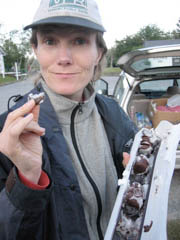
Adjunct Instructor, University of Vermont
I am a geologist by training, have been to every continent on the earth, and have been working with Science Education for the last 10 years. I direct several K-12 science programs for students, including the Governor's Institute on Science and Technology for capable VT high school students, and the Perkins Museum Environmental Science Day Camp for grades 1-7 students. My work at the Perkins Museum also includes coordination on two digital archive projects (Landscape Change Program and Perkins Digital Archive). I also teach as an Adjunct Lecturer in the Geology and Education Departments at the University of Vermont.

Don Maynard
The Johnson Company
I have collected rocks and fossils since I was young. Geology is a field
which allows me to spend about half my time outside and half in the office.
Environmental geology projects are all different, so I am always challenged,
and the work is always interesting. My work has taken me around the US,
and overseas as well.
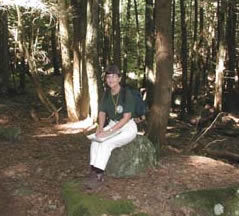
Nancy W. McHone
Connecticut Geological and Natural History
Survey
As a child I collected rocks and minerals, begging my parents to stop at every rock shop we passed on a trip we took to California when I was ten. But before I started college as a geology major, a friend of my parents who worked for an oil company convinced my parents that oil companies did not hire women geologists (this was a long time ago). So I got a degree in anthropology, then in library science. Later, when I switched librarian jobs to an academic science library, I was told I needed a masters degree in a science. Of course, I started a geology program. Part way through my first class, I realized I really wanted to work in geology, especially since I like to be outdoors.
[Picture: Nancy taking a break from mapping in Bigelow Hollow State Park in CT]
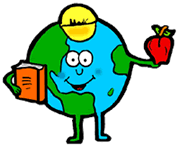
Mary Ann Mento
I got into geology throught the back door; my basic degree was chemistry, and I was asked to teach earth science also. After staying " one or two chapters ahead of my students", I found a National Science Foundation program at University of Oklahoma, enrolled, received a Master of Natural Science, and after that no longer taught earth science! I'm still interested in it however.
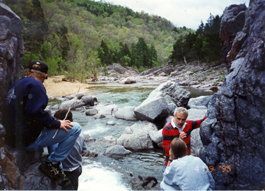
Adjunct Professor of Geology, University of New Hampshire
I had always loved maps and natural sciences, so it was logical that I would switch to Geology as a major in my junior year. My career has presented me with two great challenges: to help untangle the intellectual puzzles God presents to us in multiply deformed rocks, and to help others see the world with geological eyes. Here my students and I are looking at porphyritic rhyolite at Johnson Shut-Ins, Missouri.
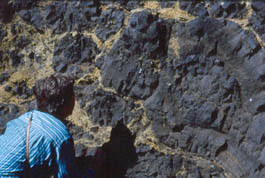
Thelma Thompson
Government Documents and Maps Librarian, University of New Hampshire
My interest in earth sciences was sparked by excellent teachers at key points in my education. In third grade, our class prepared daily weather reports for the rest of the school; in ninth grade earth science, we learned the local geology through many field trips; in college, I chose geology as my science requirement and was firmly hooked with our first lab assignment, mapping Redstone Quarry in Burlington. A love of maps and geography, interest in history, and being outdoors exploring new places all came together in geology. I don't get in the field as much as I would like these days, but in my position as a librarian specializing in maps and geoscience information I help others do geological research.
[Picture: 1993 Geological Society of America field trip to Iceland]
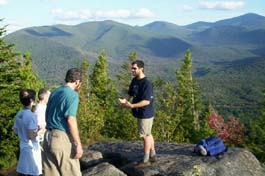
Assistant Professor of Geology, Green Mountain College
My fascination with geology began as a seven year old in the Helderberg Mountains of Upstate New York. My father built our house in an area where you couldn't dig deep basements (without dynamite) so our basement floor was a fairly flat bedding plane of the Coeymans Formation. In addition, our rock walls and fireplace were faced by pieces of the Manlius, Coeymans, and Kalkberg formations. Of course at the time I couldn't identify them by formation, but as I played in the basement and wandered around our property collecting corals and brachiopods, I knew I wanted to grow up and be a paleontologist. Although my interest in fossils waned over time, my passion for geologic processes and the interface between humans and these processes has only grown stronger. My greatest aspiration is to transfer this passion as well as a greater understanding of our physical environment to my students, friends and family.
[Picture: John teaching "Geology of the Adirondacks" class, Fall 2004]